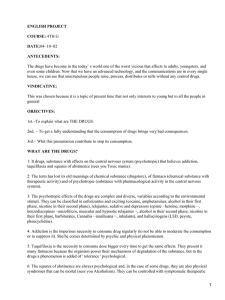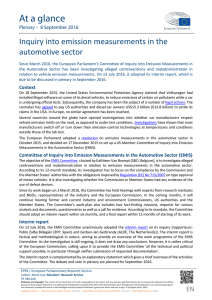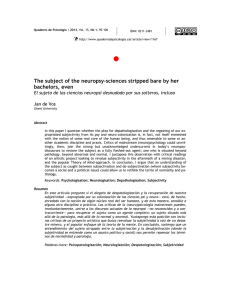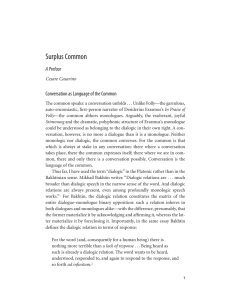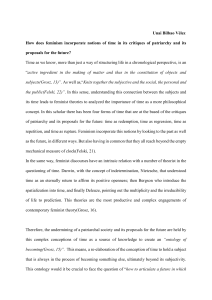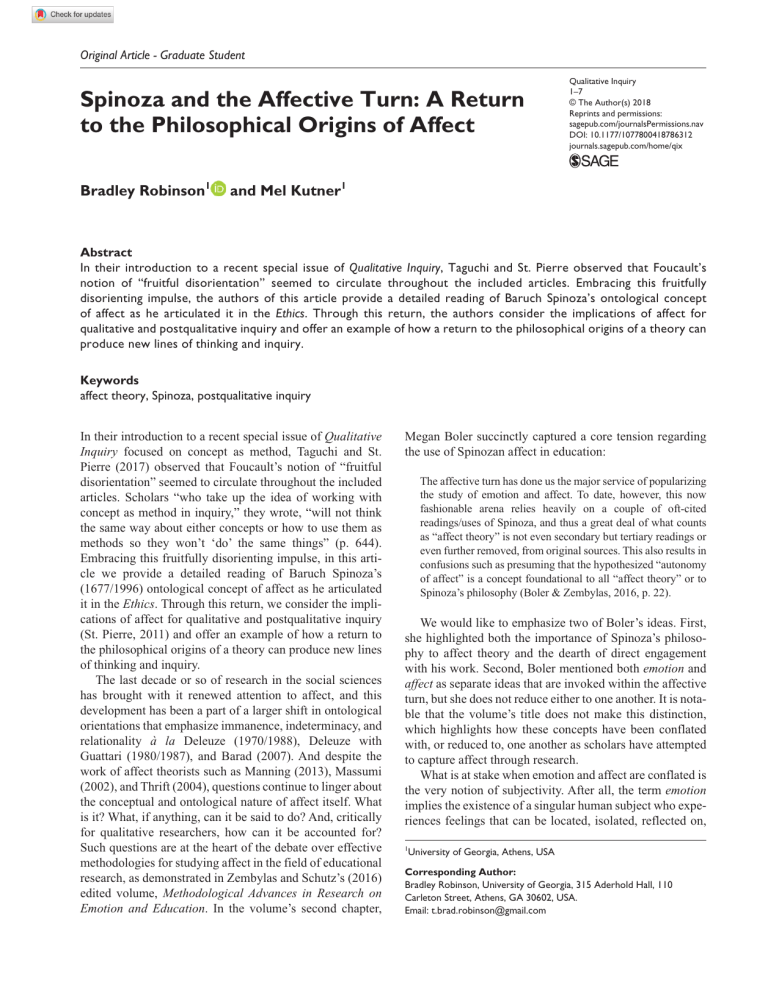
786312 research-article2018 QIXXXX10.1177/1077800418786312Qualitative InquiryRobinson and Kutner Original Article - Graduate Student Spinoza and the Affective Turn: A Return to the Philosophical Origins of Affect Bradley Robinson1 Qualitative Inquiry 1­–7 © The Author(s) 2018 Reprints and permissions: sagepub.com/journalsPermissions.nav https://doi.org/10.1177/1077800418786312 DOI: 10.1177/1077800418786312 journals.sagepub.com/home/qix and Mel Kutner1 Abstract In their introduction to a recent special issue of Qualitative Inquiry, Taguchi and St. Pierre observed that Foucault’s notion of “fruitful disorientation” seemed to circulate throughout the included articles. Embracing this fruitfully disorienting impulse, the authors of this article provide a detailed reading of Baruch Spinoza’s ontological concept of affect as he articulated it in the Ethics. Through this return, the authors consider the implications of affect for qualitative and postqualitative inquiry and offer an example of how a return to the philosophical origins of a theory can produce new lines of thinking and inquiry. Keywords affect theory, Spinoza, postqualitative inquiry In their introduction to a recent special issue of Qualitative Inquiry focused on concept as method, Taguchi and St. Pierre (2017) observed that Foucault’s notion of “fruitful disorientation” seemed to circulate throughout the included articles. Scholars “who take up the idea of working with concept as method in inquiry,” they wrote, “will not think the same way about either concepts or how to use them as methods so they won’t ‘do’ the same things” (p. 644). Embracing this fruitfully disorienting impulse, in this article we provide a detailed reading of Baruch Spinoza’s (1677/1996) ontological concept of affect as he articulated it in the Ethics. Through this return, we consider the implications of affect for qualitative and postqualitative inquiry (St. Pierre, 2011) and offer an example of how a return to the philosophical origins of a theory can produce new lines of thinking and inquiry. The last decade or so of research in the social sciences has brought with it renewed attention to affect, and this development has been a part of a larger shift in ontological orientations that emphasize immanence, indeterminacy, and relationality à la Deleuze (1970/1988), Deleuze with Guattari (1980/1987), and Barad (2007). And despite the work of affect theorists such as Manning (2013), Massumi (2002), and Thrift (2004), questions continue to linger about the conceptual and ontological nature of affect itself. What is it? What, if anything, can it be said to do? And, critically for qualitative researchers, how can it be accounted for? Such questions are at the heart of the debate over effective methodologies for studying affect in the field of educational research, as demonstrated in Zembylas and Schutz’s (2016) edited volume, Methodological Advances in Research on Emotion and Education. In the volume’s second chapter, Megan Boler succinctly captured a core tension regarding the use of Spinozan affect in education: The affective turn has done us the major service of popularizing the study of emotion and affect. To date, however, this now fashionable arena relies heavily on a couple of oft-cited readings/uses of Spinoza, and thus a great deal of what counts as “affect theory” is not even secondary but tertiary readings or even further removed, from original sources. This also results in confusions such as presuming that the hypothesized “autonomy of affect” is a concept foundational to all “affect theory” or to Spinoza’s philosophy (Boler & Zembylas, 2016, p. 22). We would like to emphasize two of Boler’s ideas. First, she highlighted both the importance of Spinoza’s philosophy to affect theory and the dearth of direct engagement with his work. Second, Boler mentioned both emotion and affect as separate ideas that are invoked within the affective turn, but she does not reduce either to one another. It is notable that the volume’s title does not make this distinction, which highlights how these concepts have been conflated with, or reduced to, one another as scholars have attempted to capture affect through research. What is at stake when emotion and affect are conflated is the very notion of subjectivity. After all, the term emotion implies the existence of a singular human subject who experiences feelings that can be located, isolated, reflected on, 1 University of Georgia, Athens, USA Corresponding Author: Bradley Robinson, University of Georgia, 315 Aderhold Hall, 110 Carleton Street, Athens, GA 30602, USA. Email: [email protected] 2 and measured. This emotion-experiencing subject is the Cartesian cogito—the I, the rational, essential self. In this system of thought, affect can only be synonymous with human emotion, and researchers who attempt to map a Spinozan conception of affect onto this system of thought are likely to experience unfruitful disorientation. A conception of affect derived from Spinoza’s work, is only thinkable in a relational ontological arrangement in which affect emerges as necessarily entangled with memories and materials, sensations and spaces. This Spinozan conception of affect subsumes emotion and cannot be reduced to specific feelings of happiness or sorrow. If we were forced to use the word “emotion,” we might say that affect is, in this way, posthuman emotion. These are difficult concepts to wrap one’s head around, and in response, some may critique Spinozan affect’s ontological assumptions, claiming that any such notion of affect must necessarily escape discursive capture and would therefore be irrelevant and inaccessible to inquiry. Such charges, we argue, may result from misconceptions over what posthuman subjectivity is. Crucially, posthuman subjectivity is not the denial of subjective experience—yes, you are interacting with this text right now—but rather it acknowledges the dispersal of subjectivity across indeterminate assemblages of human and nonhuman material—no, it is not only you intra-acting with this text right now. As Deleuze and Guattari (1980/1987) noted, “There is no longer a tripartite division between the field of reality (the world) and a field of representation (the book) and a field of subjectivity (the author)” (p. 23). In this way, the “I” is a production, not simply a producer. Such posthuman orientations work not to deny subjective experiences, or the experience of subjectivity, but rather to argue that they are produced by dispersed and dynamic, not fixed and static, affective flows. In other words, to move past the cogito is not to reject the existence of emotion; instead, such a move suggests that emotions never spring from within a body but are produced through a circulating relationality between and among bodies. This is affect—dispersed subjectivity, posthuman emotion so diffuse it travels through crowds, up mountains, and down spines. This conception of affect only became thinkable for us after deep engagement and struggle with the Ethics, in which Spinoza articulates his notion of affect and its role in his overall ontological arrangement. As Boler suggested in her interview with Zembylas, however, few scholars working with affect theory appear to have engaged with Spinoza’s texts directly, even if through translations. And it seems to us that to the extent Spinoza’s name has been invoked in affect theory scholarship, it is often in reference to Deleuze’s, and Deleuze with Guattari’s, invocations of him. In the sections that follow, we aim to move the discussion around affect theory closer to its primary source by providing a description of the Spinozan ontological framework Qualitative Inquiry 00(0) through which posthuman affect becomes thinkable. We, of course, recognize that our reading of Spinoza is not and cannot be functionally equivalent to reading the Ethics oneself—which we highly recommend, by the way—but we still hope that our description will help readers think differently about affect theory in qualitative and postqualitative inquiry. The Origins of Affect in Spinoza’s Ethics Written in the mid-17th century, Spinoza’s Ethics is a challenging read for a number of reasons. First, the text is conceptually dense, and because Spinoza is largely cutting from whole cloth, many of those dense concepts are new to readers (e.g., adequate and inadequate ideas). Second, Spinoza’s argument takes the form of a geometric proof with definitions, axioms, postulates, propositions, and demonstrations—a rhetorical move, perhaps, intended to elevate his philosophy to the status of Euclidean geometry. For readers, however, Spinoza’s geometric method challenges us to track all the definitions etcetera, which he references by parenthetical abbreviations throughout the text to synthesize various components of his broader argument. Third, as it was originally written in Latin—yet another rhetorical move, likely—readers of English translations must linger in the uncertainty inherent to translated texts. Reading the Ethics, we found it useful to entangle our own experiences with the text, to lodge ourselves in its obtuse angles, and then to work ourselves out of them. For example, Brad found it useful to think about his experience moving to Georgia, where the heat of the sun led him to suspect it might actually be closer to the earth than it was in his previous home of North Carolina. Indeed, Spinoza used such an example in the Ethics to demonstrate his conception of inadequate ideas: Similarly, when we look at the sun, we imagine it as about two hundred feet away from us, an error which does not consist simply in this imagining, but in the fact that while we imagine it this way, we are ignorant of its true distance and of the cause of this imagining. For even if we later come to know it is more than six hundred diameters of the earth away from us, we nevertheless imagine it as near. For we imagine the sun so near not because we do not know its true distance, but because an affection of our body involves the essence of the sun insofar as our body is affected by the sun. (p. 59) In other words, that the sun may have seemed—to Brad, at least—closer to the earth in Georgia than in North Carolina was due to the intensity of its effects on his body to the extent that his mind understood them. Indeed, for Spinoza, at the moment in time when Brad’s body experienced an intensity leading him to imagine something false, he was blind to the fact that the sun is, according to Spinoza, 3 Robinson and Kutner around 600 diameters away from the earth. Despite Brad’s knowledge that the sun is not actually any closer to the earth in Georgia, it felt to him that way, Spinoza explained, “because an affection of [his] body involves the essence of the sun insofar as [his] body was affected by the sun” (p. 54). What Brad was left with, then, were what Spinoza called inadequate ideas of both the sun and his body. But what is an inadequate idea? What would an adequate idea look like? What does Spinoza mean by affection? Finally, what does all this have to do with affect theory? To answer these questions, one must first come to some understanding of Spinoza’s ontology. And, it all comes from substance. Substance For Spinoza, substance is “that whose concept does not require the concept of another thing, from which it must be formed” (p. 1). Substance, then, is that which cannot be divided and which constitutes all things which can be divided. The immanence of substance is fundamental to Spinoza’s ontological monism, and it stands in contrast to Descartes’s conception of dual substances: mind and body. Beginning from substance, Spinoza goes on to describe his new, anti-Cartesian system of thought that is only thinkable in monist terms. Consequently, we, the authors, must be careful in how we describe this system of thought, and our readers must be careful as well, making sure we all think substance. (Perhaps this will not be too difficult, however, given the influence of quantum and particle physics on modern conceptions of reality.) A reader of the Ethics might object to our characterization of Spinoza’s substance, arguing that he made it clear that God is immanent, that God is the true, infinite cause of all things. It is true that Spinoza used the word “God” throughout the Ethics, but he explained his unique conception of God in Part I, Proposition 11: “God, or a substance consisting of infinite attributes, each of which expresses eternal and infinite essence, necessarily exists” (p. 41). God is substance, and Substance is God. (Readers of the Ethics, and of this article, may find it helpful to replace the word “God” with “substance” anytime they encounter it.) Furthermore, substance is only understood by the intellect through its attributes, or characteristics, and God’s infinite intellect can comprehend infinite attributes of substance. The human mind, however, can only comprehend two attributes of substance: thought and extension (i.e., matter). Consequently, the infinite nature of substance alwaysalready exceeds the human mind’s ability to apprehend it. Thought is an attribute of substance that manifests only in the mind, whereas extension is an attribute of substance that manifests only in space, individuating bodies through relations of “speed and slowness” (p. 41). It is in this division between two different attributes of the same substance that we, the authors, and our readers must be careful as it would be easy to align Spinoza’s thought and extension with Descartes’s mind and body. To do so, however, would be to conflate two incommensurable ontological frameworks. For his part, Spinoza insisted that “the thinking substance and the extended substance are one and the same substance, which is now comprehended under this attribute, now under that” (p. 35). In fruitfully disorienting terms, Spinoza’s notions of mind and body are different, yet the same. To think posthuman subjectivity, then, it is useful to reckon with the implications of both Spinoza’s substance and his distinction between thought-as-substance and extension-assubstance. If it is the case that posthuman subjectivity is dispersed and dynamic, not localized and static, one can see how Spinoza’s conception of substance allowed him to lay out a plane of immanence upon which posthuman subjectivity could circulate and unfold. Mode Spinoza populated his plane with many other concepts, including that of mode, a concept which allowed him to describe specific manifestations of substance-as-thought and substance-as-extension. And it is worth repeating here that thought and extension are the only two attributes of substance the human intellect can comprehend. “By mode,” Spinoza wrote, “I understand the affections of substance, or that which is in another through which it is also conceived” (p. 1). To understand this, it helps to understand first what Spinoza meant by affection, or affectio in Latin. An affection is a mode of substance—either one of thought or one of extension—as it entangles with other modes of substance. The term affection emphasizes how modes of thought encounter and co-constitute one another, and also how modes of extension encounter and co-constitute one another. To return to Brad’s experience with the sun, when it occurred to him that the sun might be closer to the earth in Georgia, he was reckoning with the intensity of the relation between his body and the sun, both of which are modes of extension, and this interaction constitutes a relation of affection. Although Spinoza collapsed this relation into the phrase “affection of our body,” it is crucial to keep in mind the active, relational quality of affections. For Spinoza, this entangling of modes of substance was quite literal—the sun’s substance entangled with the substance that is Brad’s body—and this relation of affection was so intense that he became blind to true causes and was momentarily tempted to conclude that the sun may in fact be closer to Georgia. The second half of Spinoza’s definition of mode, indeed the trickier half, defines mode as “that which is in another through which it is also conceived” (p. 1). This paradoxical phrase may seem more obfuscating than clarifying, but it is nevertheless important to understanding Spinoza’s concept of mode. How can a mode be “in another”? Indeed, in another what? And how can a mode be “in another” and 4 “conceived” through it? Here, we offer two interpretations, each of which depends on how one understands “conceived,” or concipitur in Latin. If “conceived” means “becomes,” then Spinoza was suggesting that modes exist within the same substance through which they come to be, an interpretation which highlights their entangled, co-constitutive nature. Alternatively, or perhaps complementarily, if “conceived” means “comprehended” (i.e., understood), then Spinoza was suggesting that the processes by which the mind experiences modes of thought and extension are functions of relations of affection. Both interpretations assume the immanence of substance, and we suggest that is the crucial takeaway. Spinoza’s modes are unique manifestations of substance as they exist in relations of affection between bodies and other bodies, between thoughts and other thoughts. All the discussion so far begs a vexing question: How can relations of affection between extensive modes (e.g., bodies) be apprehended by the human intellect, itself a mode of thought? How does the mind develop an idea of the body if they are each different modes of substance under different, mutually exclusive attributes? How was Brad’s mind able to develop an idea of the sun’s effect on his body? These questions point to the mind–body problem, the Cartesian split. Spinoza’s solution to the problem is this: “The object of the idea constituting the human mind is the body, or a certain mode of extension which actually exists, and nothing else” (p. 39). That is to say, although the human mind is itself a mode of thought, it can only experience itself as a mode of extension (e.g., a body) entangled with other modes of extension because the body is the object of the mind’s thought. Put differently, thought is necessarily embodied. Ultimately, then, the physical body is a mode of extension, the idea of the physical body is a mode of thought, and these two modes are united as the same substance under different attributes. Inadequate Ideas Crucially, however, because the mind and body are mutually exclusive modes of the same substance, Spinoza claimed that “the ideas of the affections of the human body, insofar as they are related to the human mind, are not clear and distinct, but confused” (p. 51). They are inadequate ideas. That is, the mind can by its nature only have inadequate ideas of modes of extension, including the physical body which is the mind’s object of thought. Spinoza added that “the human mind does not perceive any external body as actually existing, except through the ideas of the affections of its own body” (p. 50), which again are necessarily inadequate and confused ideas. Perhaps one can now understand how Brad’s superficial idea of the sun’s proximity to the earth was clearly inadequate, but more importantly, perhaps one can understand how Brad’s idea of the sun will Qualitative Inquiry 00(0) remain inadequate so long as he remains a thinking thing. Yes, he can be reasonably sure there is a sun as a result of the relations of affection between substantive bodies, but his idea of both bodies is necessarily inadequate. Indeed, Spinoza was not immune to such inadequate ideas himself, as his reference to the sun’s distance from the earth (over 600 diameters of the earth, he claimed), while technically and minimally correct, understated the distance by approximately 88,209,500 miles based on our calculations. Adequate Ideas So far we have discussed the relations among Spinoza’s concepts of substance, attributes, affections, and modes, explaining how they inevitably lead to inadequate ideas. But all this begs another question: What constitutes an adequate idea? Assuming it is possible to do so—and perhaps it isn’t—how might Brad arrive at an adequate idea of the relation between his body and the sun? It is here that we turn to Spinoza’s concept of affect, or affectus in Latin, which Spinoza defined as follows: “By affect I understand affections of the body by which the body’s power of acting is increased or diminished, aided or restrained, and at the same time, the ideas of these affections” (p. 70). Here Spinoza seems to equate “affect” with “affections of the body” inasmuch as they both can increase or decrease the “body’s power of acting.” Note, however, that in the first half of the definition, the human mind is not to be found; it is all about bodies, about relations of affection that either elevate or depress a body’s conatus—that is, its striving, its ability to maintain those individuating relations of “speed and slowness” that hold it together. Affect, then, is both dispersed and dynamic, not located in or reducible to the cogito. It is only toward the end of the definition that we encounter the mind: “and at the same time, the ideas of these affections” (emphasis added). Spinoza made an important distinction here, one that laid out the plane of immanence within which posthuman subjectivity could emerge and circulate. Although affects are precisely those relations of affections that either strengthen or weaken bodies, they are simultaneously the human mind’s idea of those relations of affections. And such ideas will be either adequate or inadequate to the extent that the mind is, respectively, either acting or being acted on. Affect Returning to Brad and that blazing Georgia sun, then, one can see both dimensions of affect at work. First, the relation of affection between the sun and his body was affective in that the sun lowered his body’s power of acting, but that affective response existed in a dispersed, dynamic, nonconscious arrangement between physical bodies. As Spinoza 5 Robinson and Kutner explained, however, because “the object of the idea constituting the human mind is the body” (p. 39), after a few moments of insufferable heat Brad’s mind entered into a relation of affection between that of his body and the sun— and other bodies, too—which is to say his mind conceived an idea of the sun’s power on his body. It was an inadequate idea that prompted him to suspect the sun was closer to the earth in Georgia. Only a moment later, however, his mind understood that this was, of course, not true. It only seemed that way, perhaps, because he had just stepped from an airconditioned vehicle onto pavement radiating intense waves of heat. For Spinoza, such rational engagement between the mind and its ideas of relations of affection can lead to more adequate ideas of those relations of affection. He wrote, “Our mind does certain things [acts] and undergoes certain things, namely insofar as it has adequate ideas, it necessarily does things, and insofar as it has inadequate ideas, it necessarily undergoes things” (p. 70). Clearly, then, Brad’s wrong-headed impression of the sun was a result of “undergoing,” or enduring, the power of the sun, and he was therefore limited to an inadequate idea of it. But Spinoza added that “if we can be the adequate cause of any of these affections, I understand by the affect an action; otherwise, a passion” (p. 70). As a pure mode of substance-as-thought, Brad’s rational mind possessed the agentive power to become the adequate cause of the relation of affection between his mind and his inadequate idea of the sun, and this adequate idea enhanced his power to act. He continues living in Georgia, after all. Central to Spinoza’s Ethics, then, is the call to active, relational ways of being in the world that strive to rise above the passions, those external forces that obscure rather than clarify understanding. Indeed, that the words “passion” and “passive” both derive from the Latin pati, meaning to suffer, calls our attention to the ethical force of Spinoza’s philosophy. Spinozan affects can get in the mind’s way of understanding true causes, which is why Spinoza encouraged us to “separate emotions, or affects, from the thought of an external cause, and join them with other thoughts” (p. 163). When we are successful, “the love, or hate, toward the external cause is destroyed, as are the vacillations of mind arising from these affects” (p. 163). For Spinoza, then, an affect can be a sort of problem, one only the rational mind can solve as it makes its way through the levels of knowledge, working toward true knowledge of God, of Substance, of Nature. This is an important point, as affect sometimes carries a more positive valence in the work of contemporary affect theorists. Massumi (2002), for example, associates affect with the “perception of one’s own vitality, one’s sense of aliveness, of changeability (often signified as ‘freedom’)” (p. 36). For Spinoza, however, there are affects of sadness, which decrease our power of acting and lead us away from true knowledge, and there are affects of joy, which increase our power of acting and, when our rational mind is their cause, can lead us toward true knowledge. Given such nuance, when researchers position their work in a philosophical lineage of affect that includes both Spinoza and Massumi—even Massumi himself—it is easy to see how things can become confused, how inadequate ideas can abound. In her interview with Zembylas, Boler highlighted one such confusion, namely that Massumi’s “‘autonomy of affect’ is a concept foundational to all ‘affect theory’ or to Spinoza’s philosophy” (p. 23). As Spinoza makes clear, affect, or affectus, is not an entirely prepersonal intensity that always-already exceeds our capacity to engage it with it. Instead, Spinozan affect is a suprapersonal intensity, one amenable not only to discursive capture but also to rational, productive, and ethical engagement within a posthuman conception of subjectivity. Spinoza and Deleuze With Guattari Importantly, we do not claim that Spinoza’s ontological arrangement necessarily implied posthuman subjectivity and did so about three centuries ago. Rather, we claim that Spinoza’s monist ontology laid out a plane of immanence within which a thinkable conception of posthuman subjectivity could take shape. And thanks to the work of Deleuze (1970/1988) and Deleuze with Guattari (1980/1987), Feminist New Materialists like Braidotti (2006) and Barad (2007), it has and continues to take shape. However, the nuanced ontological arguments in Spinoza’s Ethics are essential to engage with in any account of affect theory that traces its philosophical lineage to Deleuze and Guattari, who themselves profess the importance of Spinoza. For example, in What is Philosophy? Deleuze and Guattari (1991/1994) anointed Spinoza as the “‘prince’ of philosophers” (p. 49)—“the only philosopher never to have compromised with transcendence and to have hunted it down everywhere,” adding that “he discovered that freedom exists only within immanence” (p. 48). Braidotti (2006) too returned to Spinoza’s conception of conatus to explore the political ethical imperatives of nomadic philosophy. It is Deleuze and Guattari’s description of affect in A Thousand Plateaus: Capitalism and Schizophrenia that seems to dominate conceptions of affect in inquiry after the ontological turn. That in mind, now that we have worked through Spinoza’s ontological arrangement, we will turn to one of Deleuze and Guattari’s most cited passages, one of just two instances where they offer something close to a definition of affect. This reading will indicate what new potentialities can emerge from affect theory following a return to Spinoza’s original philosophical origins. Deleuze and Guattari write We know nothing of the body until we know what it can do, in other words, what its affects are, how they can or cannot enter into composition with other affects, with the affects of another body, either to destroy that body or be destroyed by it, either to 6 Qualitative Inquiry 00(0) exchange actions and passions with it or to join with it in composing a more powerful body. (p. 257) A few things to note about this passage. First, it opens with a line that echoes Deleuze’s (1970/1988) book A Practical Philosophy, in which he discusses the work of Spinoza. In A Practical Philosophy, Deleuze (1988) comments that one of Spinoza’s greatest philosophical insights was that “no one has yet determined what the body can do” (p. 72). This is important to note because it indicates the extent to which Spinoza’s philosophy was foundational for Deleuze and Guattari’s constructions, although they do not state so explicitly. Second, Deleuze and Guattari implied that knowledge of the body and its affects is possible, if aspirational. As we saw earlier, the epistemological distinction between adequate and inadequate ideas is a key feature of Spinoza’s Ethics, and while Deleuze and Guattari are not as proscriptive, there is a clear epistemological implications to their ontological arguments. Third, their attention to the potential for affects to “enter into composition with other affects” seems to rely on Spinoza’s conception of modes, particularly their capacity to enter into co-constitutive relations of affection. This emphasizes the more-than-individual relationality aspect of affect. Fourth, Deleuze and Guattari preserved Spinoza’s distinction between affective actions and passions, whereby actions strengthen bodies’ strivings to cohere, to maintain their relations of “speed and slowness” (p. 41), while passions weaken bodies’ strivings to cohere, destroying them in the process. That is, affect is not simply a poetic descriptive. Affect does, and does differently in its onto-epistemic relations among bodies. In this way, Deleuze and Guattari called upon Spinoza because he raised the status of the body to that of the mind, thereby complicating them in compelling ways. However, what is left out of this invocation of Spinoza is the ethical and epistemological force of his project. Those who would grasp onto a Spinozan–Deleuzoguattarian ontology of the body without directly engaging with Spinoza’s Ethics—not to mention Deleuze’s and Deleuze with Guattari’s large corpora, as well—may miss opportunities to experience the fruitful disorientation produced by his ideas of what the will and the mind can do, thereby allowing affect to slip from their hands, which are left holding just a body. Implications for Inquiry Importantly, by our reading of Spinoza we do not mean to suggest that a return to the Ethics is all affect theory needs. Spinoza has his own problems—strict determinism, for example. What he offers, however, is the possibility of negotiating between two seemingly contradictory impulses for engaging with affect theory through inquiry. Which is to say that Spinoza helps us avoid reducing affect to humanistic emotion on one hand or some inevitably inaccessible so-called “force” on the other. By laying out a plane where posthuman subjectivity becomes thinkable, Spinoza showed how affect can exist in a discursively accessible state of excess to the body–mind. We also suggest that our return to Spinoza might be considered an act of inquiry itself, a postqualitative inquiry in which we delved into the origins of the philosophical concept of affect and in so doing were able to think something new (St. Pierre, 2017). There are two primary ways in which affect is discussed in education. First, research on affect with a posthuman inflection often leaves behind the individual student-subject or teacher-subject to investigate the school or classroom in terms of rhizomatic assemblages, or bodies with without organs. Second, research on affect in education often involves analyses that frame educational environments, practices, or moments in terms of lines of flight, or conditions of emergent becoming. Our reading of Spinoza led us to think about the ethical force of Spinozan affect in education, which we will relate here to curriculum theory. In Latin, the word curriculum refers to the running of a course, or a race. Some curriculum theorists have noted how this metaphorical course has become increasingly literal—“Race” to the top, for example—with regimented curricular maps and standards. Such theorists note, too, how social and physical environments are not separate from, but rather are a part of, those curricular courses. Drawing on our reading of Spinoza, it occurred to us that an alternative way to consider curriculum—a way more in the spirit of its etymology—is to emphasize the movement toward which it hints, the act of running. By these lights, we came to consider the possibility of a curriculum of affective joy. Such a curriculum would attend to the how assemblages cultivate increasingly adequate, ethical ideas of the world in educational spaces through rhizomatic, not utilitarian, action. This example is provided not to argue specifically for this construction but rather to present just one possibility of how inquiry into the Spinozan philosophical origins of affect theory allowed us to think of something new. In Thinking with Theory in Qualitative Research, Youngblood Jackson and Mazzei (2012) showed how different theoretical and philosophical orientations could be “plugged in” to the same set of interview data to produce different—but not better or worse—analyses. Our return to Spinoza provided a different type of thinking with theory, one that used theory to drive potential questions for inquiry. For example, one could imagine projects to investigate the curricular and instructional implications of affect as they relate to Spinoza’s concepts of adequate and inadequate ideas or of the connections between affective joy and action all within the Deleuzoguattarian assemblage. These were not questions that we were capable of considering ahead of our reading of Spinoza’s Ethics. 7 Robinson and Kutner Conclusion Declaration of Conflicting Interests Boler, M., & Zembylas, M. (2016). Interview with Megan Boler: From “feminist politics of emotions” to the “affective turn.” In M. Zembylas & P. Schutz (Eds.), Methodological advances in research on education and emotion (pp. 203-214). Basel, Switzerland: Springer. Braidotti, R. (2006). The ethics of becoming imperceptible. In C. Boundas (Ed.), Deleuze and philosophy (pp. 133-159). Edinburg, UK: Edinburgh University Press. Deleuze, G. (1988). Spinoza: Practical philosophy (R. Hurley, Trans.). San Francisco, CA: City Lights Books. (Original work was published 1970) Deleuze, G., & Guattari, F. (1987). A thousand plateaus: Schizophrenia and capitalism (B. Massumi, Trans.). Minneapolis: University of Minnesota Press. (Original work published 1980) Deleuze, G., & Guattari, F. (1994). What is philosophy? (H. Tomlinson & G. Burchell Trans.). New York, NY: Columbia University Press. (Original work published in 1991) Jackson, A. Y., & Mazzei, L. A. (2012). Thinking with theory in qualitative research: Viewing data across multiple perspectives. New York, NY: Routledge. Manning, E. (2013). Always more than one: Individuation’s dance. Durham, NC: Duke University Press. Massumi, B. (2002). Parables for the virtual: Movement, affect, sensation. Durham, NC: Duke University Press. Spinoza, B. (1996). Ethics. New York, NY: Penguin. (Original work published 1677) St. Pierre, E. A. (2011a). “Post qualitative research: The critique and the coming after”. In Sage handbook of qualitative inquiry, 4th ed., Edited by: Denzin, N. K. and Lincoln, Y. S. 611–625. Los Angeles, CA: Sage. St Pierre, E. A. (2017). Haecceity: Laying Out a Plane for Post Qualitative Inquiry. Qualitative Inquiry, 23(9), 686-698. Taguchi, H. L., & St Pierre, E. A. (2017). Using concept as method in educational and social science inquiry. Qualitative Inquiry, 22, 643-648. Thrift, N. (2004). Intensities of feeling: Towards a spatial politics of affect. Geografiska Annaler: Series B, Human Geography, 86, 57-78. Zembylas, M., & Schutz, P. A. (Eds.). (2016). Methodological advances in research on education and emotion. Switzerland: Springer. The author(s) declared no potential conflicts of interest with respect to the research, authorship, and/or publication of this article. Author Biographies The notion that affect always-already exceeds subjective experience may represent both the theory’s greatest strength and its greatest limitation. Affect theory is an attempt to give voice to a crucial something, a haunting that is traceable but always slipping. This is a problematic paradox for researchers, especially researchers working in humanist social sciences such as education, where “useful” concepts are those amenable to methodological application. As Boler suggested in her interview with Zembylas (2016), scholars want to be put affect theory “to work” (p. 23). The challenge is how to put affect theory to work in ways that fulfill its theoretical potential without either reducing it to psychological conventions that focus on individual feelings and emotions or dismissing it as free-floating signification. In this article, we have argued that one way to meet this challenge is through a re-engagement with the primary philosophical origins of affect in Spinoza’s Ethics. Our re-engagement with the Ethics called our attention to various conceptual tools that may support fruitfully disorienting inquiry with affect theory: adequate and inadequate ideas, affections, modes, substance, joy, sadness, and so on. Our reading of Spinoza also helped make affect theory thinkable by clarifying the philosophical origins of posthuman subjectivity, which would be crucial for any scholar attempting to engage in inquiry in a posthuman ontological turn. Furthermore, inquiry is not only about how we ask it but also about what we ask. Our return to Spinoza suggested to us that inquiry related to affect is not only about the possibilities of capturing affect through research but also about returning to affect theory to ask something different, to think and create something different. To do so, a return to the philosophical origins of theory is essential. Make no mistake, this is difficult work, but as we continue reading, thinking, and writing our way around affect theory, we like to keep in mind one of Spinoza’s pithier constructions: “But all things excellent are as difficult as they are rare” (p. 181). Funding The author(s) received no financial support for the research, authorship, and/or publication of this article. ORCID iD Bradley Robinson https://orcid.org/0000-0002-2983-0206 References Barad, K. (2007). Meeting the universe halfway: Quantum physics and the entanglement of matter and meaning. Durham, NC: Duke University Press. Bradley Robinson is a doctoral student in the Department of Language and Literacy Education at the University of Georgia. He is a National Board certified teacher in English Language Arts with over a decade of experience in North Carolina’s public schools. His research explores the intersections of literacy, technology, and neoliberalism in formal and informal educational spaces. Mel Kutner is a doctoral student and graduate research assistant in the Department of Education of Education Theory and Practice at the University of Georgia. They have a master’s degree in Conflict Analysis and Resolution and eight years experience in educational policy and research. Mel’s work explores theorizations of temporality and movement in inquiry and ethics, as well as the circulation of conflict in educational spaces.

